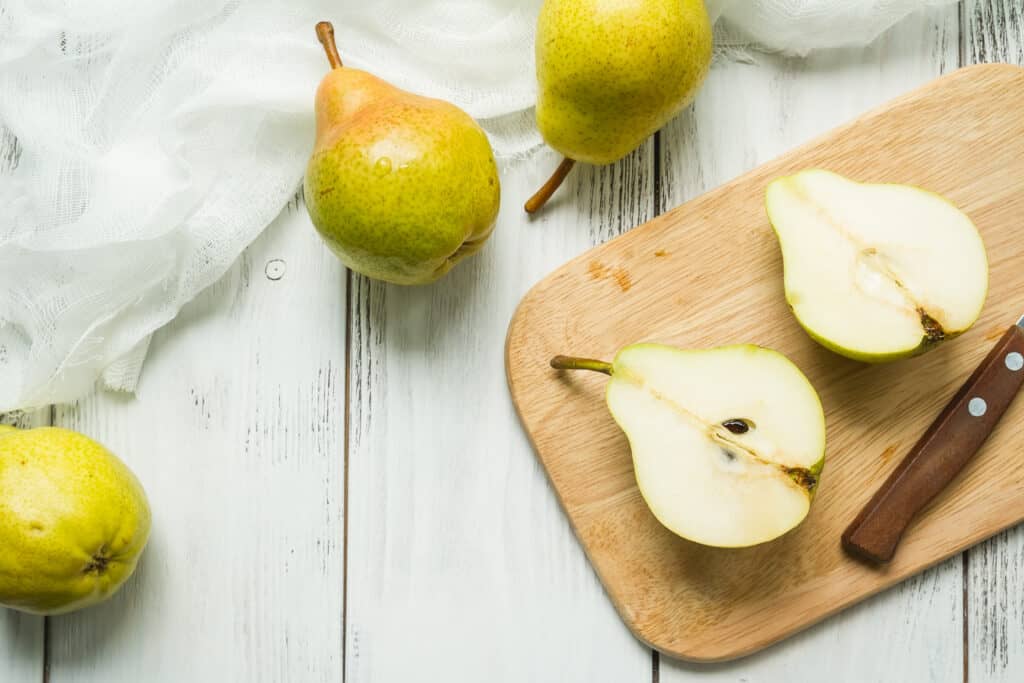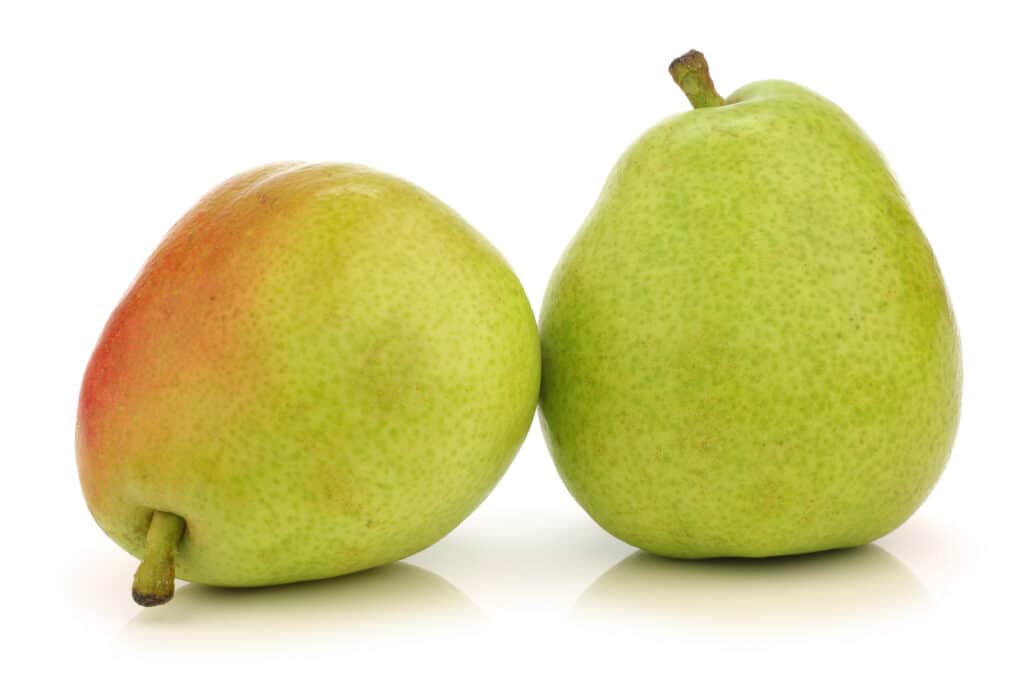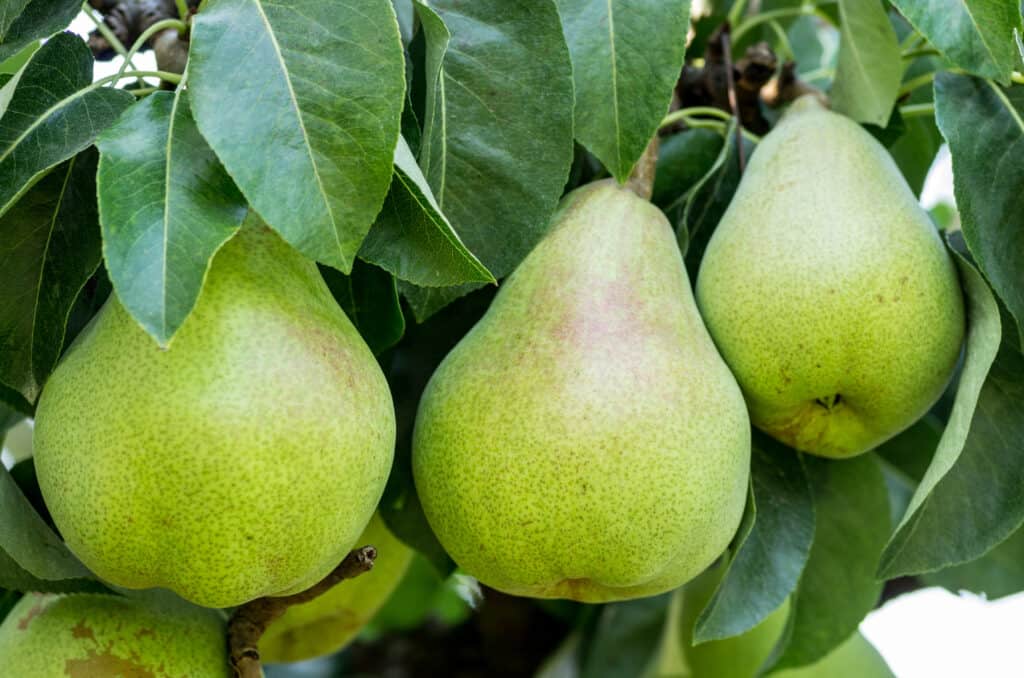Pears have been a favorite snack in North America since the 17th century when European immigrants arrived with pear trees. Thanks to their smooth texture, colonizers referred to pears as butter fruit. Bartlett pears and Anjou pears arrived somewhat later but have since become two of the most popular varieties of pears grown in the U.S. Read on to discover the key differences that affect their growth habit, flavor profile, and appearance.

Pears have been a favorite snack in North America since the 17th century when European immigrants arrived with pear trees.
©KatyaPulina/Shutterstock.com
Bartlett Pear vs. Anjou Pear
| Bartlett Pear | Anjou Pear | |
|---|---|---|
| Classification | Pyrus communis ‘Williams’ | Pyrus communis ‘Anjou’ |
| Alternative Names | Williams pear, Williams’ bon chrétien (Good Christian) pear, wild pear, choke pear | D’Anjou, Beurré d’ Anjou, Nec Plus Meuris |
| Origin | England | Belgium |
| Description | Trees grow 15-20 feet tall with a 15-20 foot width. Grows up to 2 feet per year. Blossoms are white, and the fruit is bell-shaped with a small top and large bottom. Leaves are a waxy green and elliptical. Fruit color ranges from light yellow-green to red with a white to cream-colored inside. | Bartlett pear trees are partially self-pollinating. They’ll produce some fruit on their own but have a higher yield when other trees are present. |
| Uses | Trees go 12-15 feet tall with an 8-10 foot width. Grows 1-1.5 feet per year. Blossoms are white and the fruit is oval with a slightly wider bottom. Leaves are a waxy green and elliptical. Fruit color ranges from light yellow-green to deep red with a white to cream-colored inside. | Primarily used for culinary purposes, Bartletts are a favorite for eating raw or putting on salads. They’re also the preferred pear for canning. |
| Growth Tips | Primarily used for culinary purposes, Anjous are a favorite for baking and poaching due to their density. Also great eaten raw or on salads. | This fast-growing tree thrives in full sun. Plant in acidic soil at least 15 feet from the house in USDA Zones 5-7. Soil should be well-draining with continuous watering during dry periods. |
| Interesting Features | This fast-growing tree thrives in full sun. Plant in acidic soil at least 15 feet from the house in USDA Zones 5-8. Soil should be well-draining with continuous watering during dry periods. | Anjou pear trees are not self-pollinating and require another pear tree to bear fruit. It can be pollinated by a nearby Bartlett pear tree. |
| Flavor Profile | Tangy, sweet, and bright with citrus notes. | Tangy, sweet, bright with citrus notes. |
Bartlett Pear vs. Anjou Pear: Key Differences
Bartlett pears and Anjou pears are cultivars of the same family. Their taste, texture, and pollination requirements are the most notable differences.
Bartlett pears are softer and more buttery than Anjou pears. The Bartlett has the iconic pear taste, while Anjou offers a touch of citrus. The density of the anjou makes it more versatile for cooking.
Bartlett pears have the traditional pear shape, with a definitively narrow top and wide, bell-shaped bottom. Anjou pears are more ovaline and evenly proportioned.
Bartlett trees can self-pollinate, though they produce more fruit when cross-pollination occurs. Anjou trees require cross-pollination. However, the pollen can be from a different variety of pear.
The harvest season also varies. Bartlett pears are considered summer pears, as they’re harvested in August and September, whereas Anjou pears are fall pears, harvested in late October.

The density of the anjou makes it more versatile for cooking.
©Peter Zijlstra/Shutterstock.com
Bartlett Pear vs. Anjou Pear: Classification
Both Bartlett pears and Anjou pears are cultivars of the Pyrus communis species. Pyrus communis is the common pear, specifically referring to pears of European origin.
Bartlett Pear vs. Anjou Pear: Origin
Bartlett pears originated in England in the 1700s. Schoolmaster John Stair discovered the pear was originally referred to as the Stair pear. Years later, a nurseryman named Mr. Williams would appropriate Stair’s pear, which is why the Bartlett is often called a Williams pear.
Imported to North America circa 1800, the Williams pear was planted on an estate in Massachusetts. When the estate’s owner died, the property was purchased by Enoch Bartlett, who discovered the trees, naming the delicious fruit that they produced after himself.
Mr. Bartlett’s hubris is how North America came to know the pears as Bartletts. It wasn’t until years later, when a new shipment of Williams pears arrived that it was noted that the Williams and the Bartlett were the same.
Anjou pears originated in Belgium. Upon arriving in North America, these pear were christened D’anjou (meaning from Anjou) pears, a nod to the region in France from which they were imported.
Bartlett Pear vs. Anjou Pear: Description
Identified by their traditional pear shape and yellow-green fruit, Bartlett pear trees are taller and broader than Anjou trees, though the fruit can develop red patches when overripe.

Bartlett pears are identified by their traditional pear shape and yellow-green color.
©Zigzag Mountain Art/Shutterstock.com
The white blooms and green, shiny elliptical leaves of the Anjou tree are similar to those of the Bartlett. However, Anjou trees tend to be shorter and narrower than Bartletts.
The Anjou pear is more apple-shaped, with a slightly smaller top. Rather than ripening to red, green anjou pears stay the same color as they ripen. Red Anjou pears are a sub-variety that starts off red, ripening to a rusty, maroon shade.

Anjou pears are more apple-shaped, with slightly smaller tops.
©JoannaTkaczuk/Shutterstock.com
Bartlett Pear vs. Anjou Pear: Uses
Both Bartlett and Anjou pears are delicious raw as a snack or added to salads.
Bartlett pears are sweeter with a softer texture, making them ideal for canning. Anjou pears are denser with more tang and texture, making them a popular choice for cooking, baking, and poaching as they retain more structure and bite.
Bartlett Pear vs. Anjou Pear: Growth Tips
Germinating and growing pear seeds is possible but not recommended for either variety. Seedlings take 7-10 years to bear fruit. And, besides the initial outlay of time associated with starting from seed, Bartletts and Anjous are notoriously untrue to type. Collecting and planting seeds may not produce the intended variety. Thus, gardening experts recommend starting with a grafted tree sprout.
Both Bartlett and Anjou pear trees prefer full sunlight and well-draining, damp soil. While Bartletts can self-pollinate, they produce more fruit when they can cross-pollinate, so it’s advisable to plant at least two trees, though variety is not important.
Plant pear trees 15-20 feet apart and prune them annually for optimal growth/yield.
Both Bartlett and Anjou pear trees are hardy and cold-resistant, though Anjou pear trees tend to be slightly more drought resistant than Bartletts.
Regardless of the variety of pears you choose, both Bartlett pears and Anjou pears are sweet, smooth treats that can be grown in your own backyard!
The photo featured at the top of this post is © JoannaTkaczuk/Shutterstock.com
Sources
- Goodfruit.com / Accessed November 26, 2022
- web.archive.org / Accessed November 26, 2022
- nobility.org / Accessed November 26, 2022
Thank you for reading! Have some feedback for us? Contact the AZ Animals editorial team.







